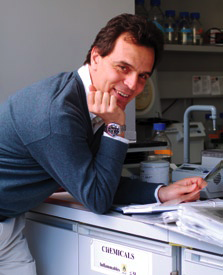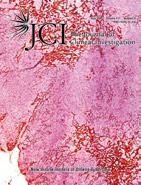on May 17, 2007
 |
 |
| Fabio Grassi | The Journal of Clinical Investigation June 2007 |
The Journal of Clinical Investigation dedicated its May cover story to a collaborative project between the IRB group of Fabio Grassi and researchers in Italy.The study validates a murine model for the devastating Omenn Syndrome, an autoimune deficiency in newborn children. In the 40 years since Harvard medical student Gilbert Omenn first described the rare, inherited disorder producing a paradoxical combination of immunodeficiency and immune dysregulation, the pathogenesis of Omenn syndrome (OS) has remained mysterious.Rag enzymes are the main players in V(D)J recombination, the process responsible for rearrangement of TCR and Ig genes Hypomorphic Rag mutations in humans, which maintain partial V(D)J activity, cause a peculiar SCID associated with autoimmune-like manifestations,Omenn syndrome (OS).
Although a deficient ability to sustain thymopoiesis and to produce a diverse T and B cell repertoire explains the increased susceptibility to severe infections, the molecular and cellular mechanisms underlying the spectrum of clinical and immunological features of OS remain poorly defined.In order to better define the molecular and cellular pathophysiology of OS, we generated a knockin murine model carrying the Rag2 R229Q mutation previously described in several patients with OS and leaky forms of SCID.
These Rag2 (R229Q/R229Q) mice showed oligoclonal T cells, absence of circulating B cells, and peripheral eosinophilia. In addition, activated T cells infiltrated gut and skin, causing diarrhea, alopecia, and, in some cases, severe erythrodermia.These findings were associated with reduced thymic expression of Aire and markedly reduced numbers of naturally occurring Tregs and NKT lymphocytes. In conclusion, Rag2(R229Q/R229Q) mice mimicked most symptoms of human OS; our findings support the notion that impaired immune tolerance and defective immune regulation are involved in the pathophysiology of OS.







